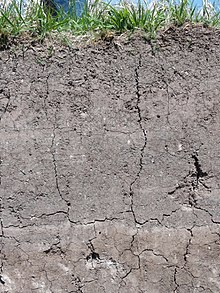Pelosol
The pelosol or clay soil (from Greek : pelos = clay and Latin : solum = soil) is a very clay-rich soil type , which is the final stage of soil development on mudstone . The soil has three horizons and is divided into class D (pelosols) by the German soil systematics . Its abbreviation is DD.
Emergence
On exposed mudstone forms quickly a plant cover , thereby forming a thin humus topsoil produced (soil type Syrosem ). As soon as the humus topsoil is thicker than 2 cm, the next stage of soil development is reached: Usually this is the Ranker (silicate claystone; ≤ 2% by weight lime); less often the pararendzina ( marly claystone;> 2 to <75% by weight lime).
Below the topsoil horizon, the mudstone is also gradually beginning to weather . If this has created another horizon in the subsoil, the soil is addressed as a pelosol. Over time this horizon becomes more and more powerful, but it no longer changes its properties significantly. The soil therefore no longer develops into other soil types and the final stage of soil formation is reached (climax soil).
distribution
Since pelosols need mudstone for their formation, their distribution is largely linked to the occurrence of this material. It is not very common, although there are scattered occurrences throughout the Central European Central Uplands . Mudstones are particularly important in the Allgäu , the East Westphalian highlands , the Thuringian Basin and the Swabian Alb .
properties
The clay minerals of the clay stones are usually high-quality 3-layer clay minerals. This means that the soils are rich in nutrients and have a high nutrient retention capacity (KAK) of around 20 cmol + . In addition, depending on the current water content, these clay minerals can absorb and release water again, which is why they swell and shrink. This creates deep cracks when it is dry and closes again when it is wet. This leads to constant shear movements in the soil, which results in a pronounced structure of coarse, sharp-edged soil aggregates (polyhedra or prisms). In addition, smooth, shiny shear surfaces (slick sides) arise at the aggregate boundaries, which are clearly visible in the soil profile .
The water balance of the soil has a number of peculiarities: the dry cracks allow precipitation to seep straight down without dampening the soil as a whole (vertical drainage). In addition, clay has little soil air (tendency to waterlogging ) and can hardly store water that is available to plants. Most of the water is so strongly bound in the soil that it cannot be reached by roots. This makes the location problematic for plants.
A special feature is self-mulch (pedogenic mixing): humus topsoil trickles deep into the soil over the cracks and is independently and homogeneously incorporated through the shear movements. Therefore, pelosols have a relatively high humus content up to great depths.
Leveling
The Pelosol is usually relatively shallow and has three horizons: Ah / P / C.
- Ah: the humus (h) topsoil horizon (A) is on the surface. It is very rich in clay. If the site is used as a field, it is called Ap (p for plowed).
- P: Below the Ah horizon begins the Pelosol horizon (P), which can only be found in this type of soil. It is the weathered, clay-rich source material. The clay content is very high (≥ 45 % by weight ), with swellable 3-layer clay minerals predominating. The horizon must begin in the top 30 cm. It shows deep cracks under dry conditions. In addition, it has a distinct structure.
- i, eC: The starting material is claystone. It can be silicate (i) or marly (e).
Related soil types
In the international soil classification World Reference Base for Soil Resources (WRB), the term Vertisol is used for swelling and shrinking clay soils . However, vertisols require special characteristics (wedge-shaped aggregates, slickensides) which are not (sufficiently) developed in many central European pelosols. In tropical and subtropical clay soils, these features are often much more pronounced. Numerous central European pelosols therefore do not belong to the vertisols in the WRB, but to the phaeozemes or cambisols with the qualifiers Vertic or Protovertic. On the other hand, vertisols require a minimum clay content of only 30%, which is why some vertisols are not pelosols, but z. B. belong to the brown earths .
The terra fusca has a similarly high clay content. However, it forms on limestone and has lower quality 2-layer clay minerals. Hence there is no swelling or shrinking in it. In addition, the nutrient retention capacity is somewhat lower.
Also marsh soils such as clay march have high clay content, but very different properties.
use
Pelosols are fertile but difficult to work with because of their extremely high clay content ( minute soil ). Above all, plowing is only possible with certain water contents and requires heavy technology. In addition, drought stress quickly occurs, as the soil can only store little plant-available water. That is why the use of arable land by pelosols is the exception in Central Europe . The use of grassland and forestry predominate .
See also
literature
- W. Amelung, H.-P. Blume , H. Fleige, R. Horn, E. Kandeler , I. Kögel-Knabner , R. Kretschmar, K. Stahr , B.-M. Wilke: Scheffer / Schachtschabel textbook of soil science. 17th edition. Heidelberg 2018. ISBN 978-3-662-55870-6 .
- AD-HOC Working Group Soil: Soil-Scientific Mapping Instructions. Ed .: Federal Institute for Geosciences and Raw Materials in cooperation with the State Geological Services, 5th, verb. and exp. Edition. Hanover 2005, ISBN 3-510-95920-5 .
- E. Mückenhausen: Soil science and its geological, geomorphological, mineralogical and petrological basis. DLG-Verlag, Frankfurt am Main 1993, ISBN 3-7690-0511-2 .
- E. Leitgeb, R. Reiter, M. English, P. Lüscher, P. Schad, KH Feger (eds.): Waldböden. An image atlas of the most important soil types from Austria, Germany and Switzerland . Wiley-VCH Verlag, Weinheim 2013, ISBN 978-3-527-32713-3 .
